Analyzing Social Influences and Body Image Perceptions in Anorexia
VerifiedAdded on 2023/06/10
|6
|1332
|173
Essay
AI Summary
This essay examines the complex relationship between anorexia nervosa, body image, and social influences. It references five articles to explore various facets of the disorder, including the cultural idealization of thinness, the social and physical repercussions of anorexia, and the societal pressures that contribute to its development in young people. The essay also discusses different treatment approaches, such as family-based therapy, cognitive behavioral therapy, and art therapy, highlighting the importance of addressing both the psychological and emotional aspects of the disorder. Art therapy is presented as a powerful tool for non-verbal expression and emotional understanding, facilitating a better connection with one's body and promoting recovery from trauma. The conclusion emphasizes the multifaceted nature of eating disorders and the need for comprehensive treatment strategies.
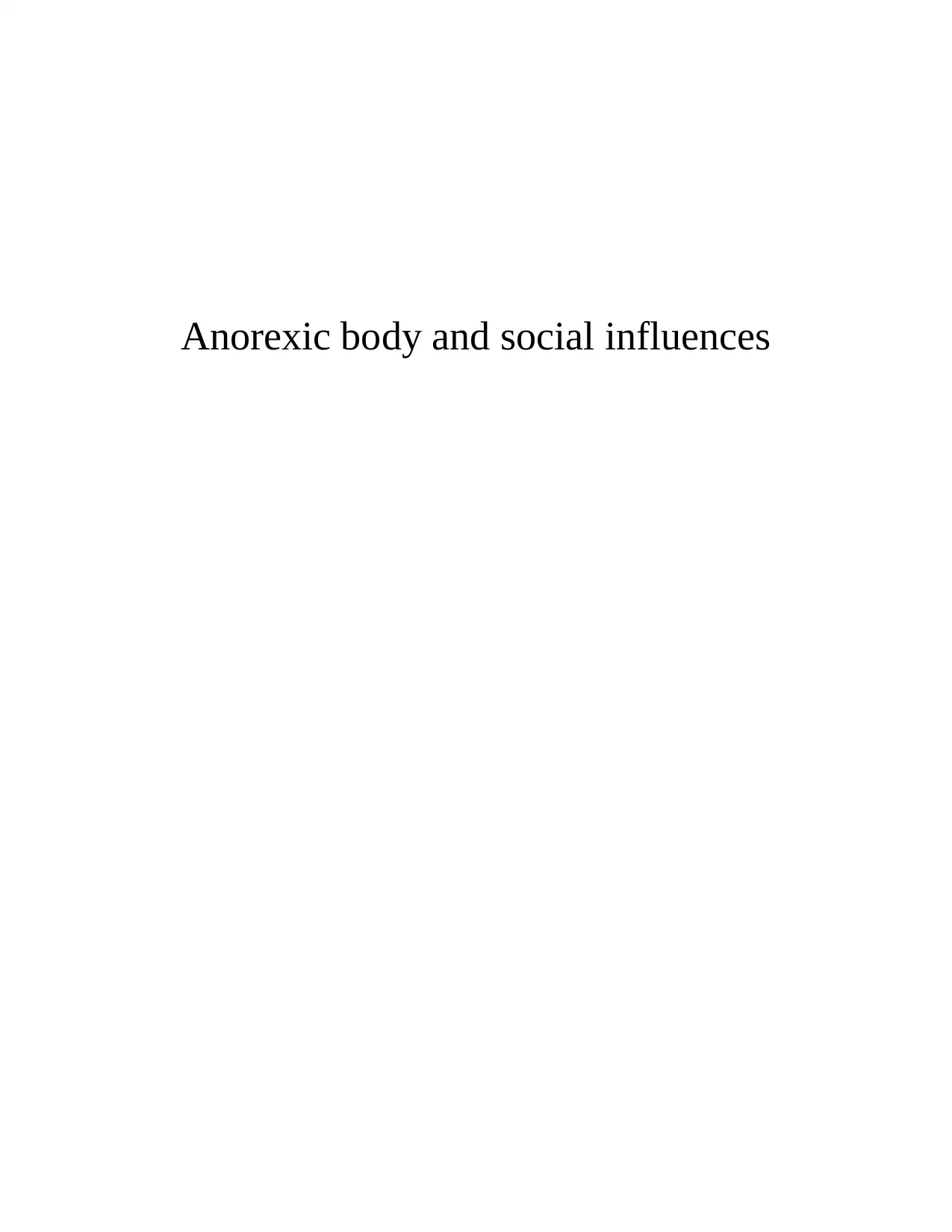
Anorexic body and social influences
Paraphrase This Document
Need a fresh take? Get an instant paraphrase of this document with our AI Paraphraser

Table of Contents
INTRODUCTION...........................................................................................................................1
MAIN BODY...................................................................................................................................1
ARTICLE 1............................................................................................................................1
ARTICLE 2............................................................................................................................1
ARTICLE 3............................................................................................................................2
ARTICLE 4............................................................................................................................2
ARTICLE 5............................................................................................................................3
CONCLUSION................................................................................................................................3
REFERENCES ...............................................................................................................................4
INTRODUCTION...........................................................................................................................1
MAIN BODY...................................................................................................................................1
ARTICLE 1............................................................................................................................1
ARTICLE 2............................................................................................................................1
ARTICLE 3............................................................................................................................2
ARTICLE 4............................................................................................................................2
ARTICLE 5............................................................................................................................3
CONCLUSION................................................................................................................................3
REFERENCES ...............................................................................................................................4
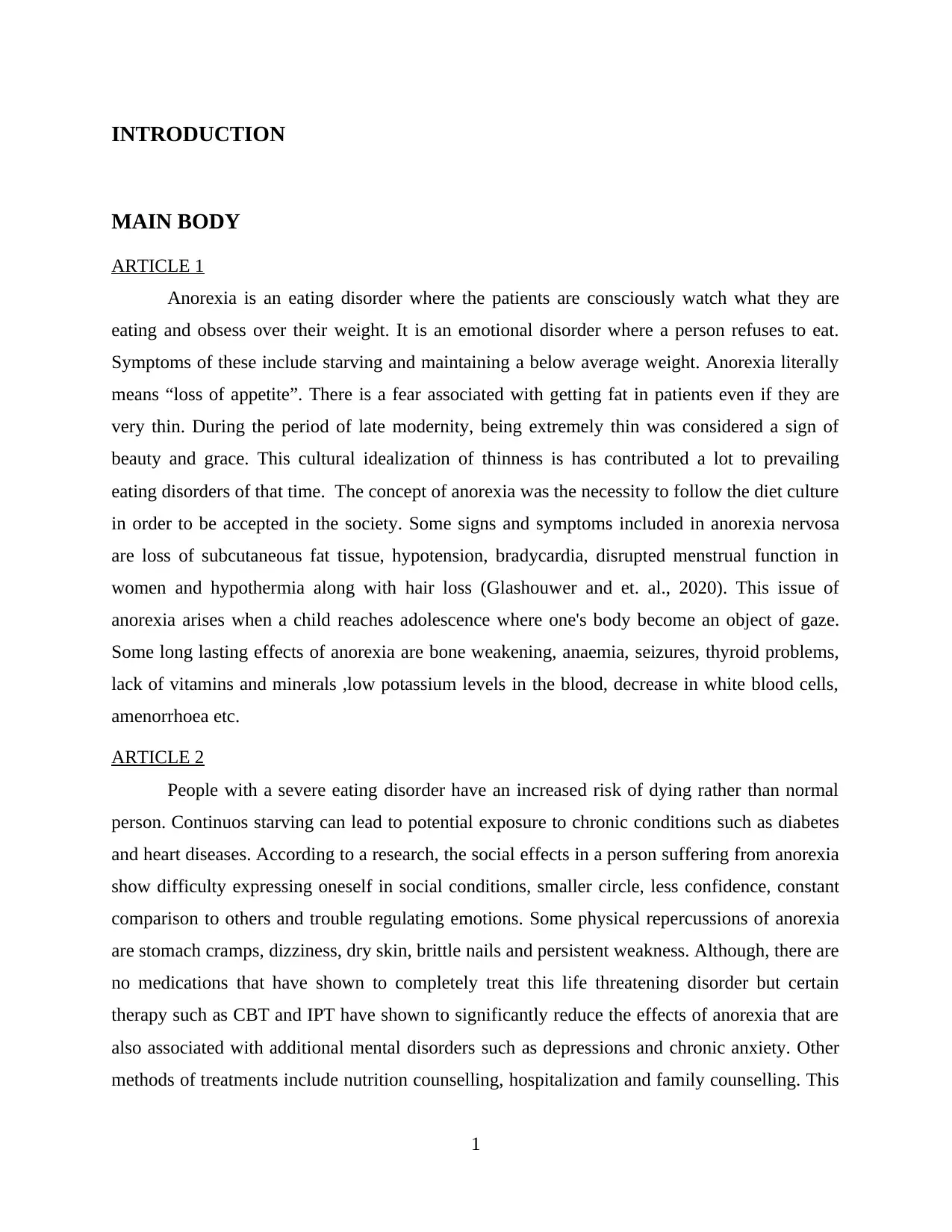
INTRODUCTION
MAIN BODY
ARTICLE 1
Anorexia is an eating disorder where the patients are consciously watch what they are
eating and obsess over their weight. It is an emotional disorder where a person refuses to eat.
Symptoms of these include starving and maintaining a below average weight. Anorexia literally
means “loss of appetite”. There is a fear associated with getting fat in patients even if they are
very thin. During the period of late modernity, being extremely thin was considered a sign of
beauty and grace. This cultural idealization of thinness is has contributed a lot to prevailing
eating disorders of that time. The concept of anorexia was the necessity to follow the diet culture
in order to be accepted in the society. Some signs and symptoms included in anorexia nervosa
are loss of subcutaneous fat tissue, hypotension, bradycardia, disrupted menstrual function in
women and hypothermia along with hair loss (Glashouwer and et. al., 2020). This issue of
anorexia arises when a child reaches adolescence where one's body become an object of gaze.
Some long lasting effects of anorexia are bone weakening, anaemia, seizures, thyroid problems,
lack of vitamins and minerals ,low potassium levels in the blood, decrease in white blood cells,
amenorrhoea etc.
ARTICLE 2
People with a severe eating disorder have an increased risk of dying rather than normal
person. Continuos starving can lead to potential exposure to chronic conditions such as diabetes
and heart diseases. According to a research, the social effects in a person suffering from anorexia
show difficulty expressing oneself in social conditions, smaller circle, less confidence, constant
comparison to others and trouble regulating emotions. Some physical repercussions of anorexia
are stomach cramps, dizziness, dry skin, brittle nails and persistent weakness. Although, there are
no medications that have shown to completely treat this life threatening disorder but certain
therapy such as CBT and IPT have shown to significantly reduce the effects of anorexia that are
also associated with additional mental disorders such as depressions and chronic anxiety. Other
methods of treatments include nutrition counselling, hospitalization and family counselling. This
1
MAIN BODY
ARTICLE 1
Anorexia is an eating disorder where the patients are consciously watch what they are
eating and obsess over their weight. It is an emotional disorder where a person refuses to eat.
Symptoms of these include starving and maintaining a below average weight. Anorexia literally
means “loss of appetite”. There is a fear associated with getting fat in patients even if they are
very thin. During the period of late modernity, being extremely thin was considered a sign of
beauty and grace. This cultural idealization of thinness is has contributed a lot to prevailing
eating disorders of that time. The concept of anorexia was the necessity to follow the diet culture
in order to be accepted in the society. Some signs and symptoms included in anorexia nervosa
are loss of subcutaneous fat tissue, hypotension, bradycardia, disrupted menstrual function in
women and hypothermia along with hair loss (Glashouwer and et. al., 2020). This issue of
anorexia arises when a child reaches adolescence where one's body become an object of gaze.
Some long lasting effects of anorexia are bone weakening, anaemia, seizures, thyroid problems,
lack of vitamins and minerals ,low potassium levels in the blood, decrease in white blood cells,
amenorrhoea etc.
ARTICLE 2
People with a severe eating disorder have an increased risk of dying rather than normal
person. Continuos starving can lead to potential exposure to chronic conditions such as diabetes
and heart diseases. According to a research, the social effects in a person suffering from anorexia
show difficulty expressing oneself in social conditions, smaller circle, less confidence, constant
comparison to others and trouble regulating emotions. Some physical repercussions of anorexia
are stomach cramps, dizziness, dry skin, brittle nails and persistent weakness. Although, there are
no medications that have shown to completely treat this life threatening disorder but certain
therapy such as CBT and IPT have shown to significantly reduce the effects of anorexia that are
also associated with additional mental disorders such as depressions and chronic anxiety. Other
methods of treatments include nutrition counselling, hospitalization and family counselling. This
1
⊘ This is a preview!⊘
Do you want full access?
Subscribe today to unlock all pages.

Trusted by 1+ million students worldwide
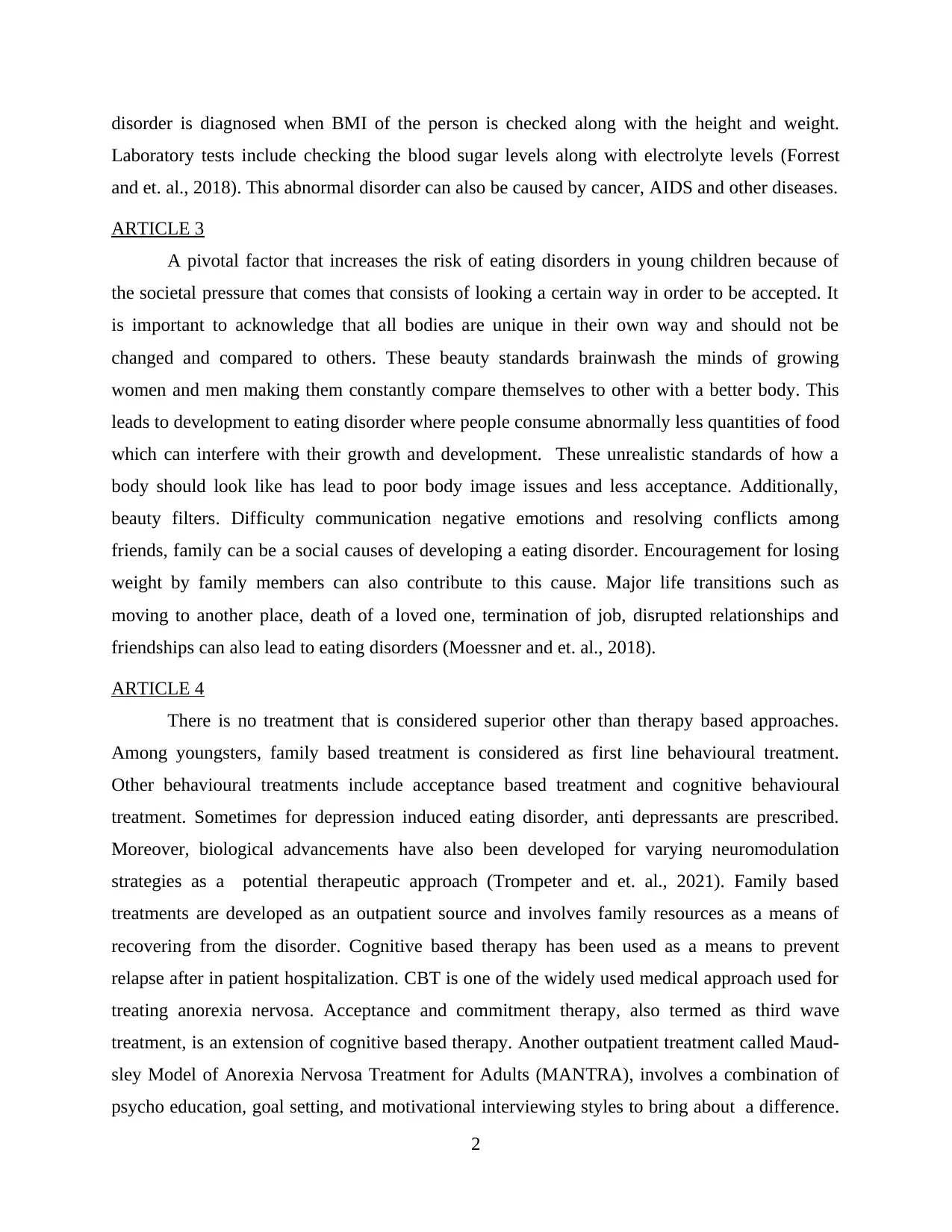
disorder is diagnosed when BMI of the person is checked along with the height and weight.
Laboratory tests include checking the blood sugar levels along with electrolyte levels (Forrest
and et. al., 2018). This abnormal disorder can also be caused by cancer, AIDS and other diseases.
ARTICLE 3
A pivotal factor that increases the risk of eating disorders in young children because of
the societal pressure that comes that consists of looking a certain way in order to be accepted. It
is important to acknowledge that all bodies are unique in their own way and should not be
changed and compared to others. These beauty standards brainwash the minds of growing
women and men making them constantly compare themselves to other with a better body. This
leads to development to eating disorder where people consume abnormally less quantities of food
which can interfere with their growth and development. These unrealistic standards of how a
body should look like has lead to poor body image issues and less acceptance. Additionally,
beauty filters. Difficulty communication negative emotions and resolving conflicts among
friends, family can be a social causes of developing a eating disorder. Encouragement for losing
weight by family members can also contribute to this cause. Major life transitions such as
moving to another place, death of a loved one, termination of job, disrupted relationships and
friendships can also lead to eating disorders (Moessner and et. al., 2018).
ARTICLE 4
There is no treatment that is considered superior other than therapy based approaches.
Among youngsters, family based treatment is considered as first line behavioural treatment.
Other behavioural treatments include acceptance based treatment and cognitive behavioural
treatment. Sometimes for depression induced eating disorder, anti depressants are prescribed.
Moreover, biological advancements have also been developed for varying neuromodulation
strategies as a potential therapeutic approach (Trompeter and et. al., 2021). Family based
treatments are developed as an outpatient source and involves family resources as a means of
recovering from the disorder. Cognitive based therapy has been used as a means to prevent
relapse after in patient hospitalization. CBT is one of the widely used medical approach used for
treating anorexia nervosa. Acceptance and commitment therapy, also termed as third wave
treatment, is an extension of cognitive based therapy. Another outpatient treatment called Maud-
sley Model of Anorexia Nervosa Treatment for Adults (MANTRA), involves a combination of
psycho education, goal setting, and motivational interviewing styles to bring about a difference.
2
Laboratory tests include checking the blood sugar levels along with electrolyte levels (Forrest
and et. al., 2018). This abnormal disorder can also be caused by cancer, AIDS and other diseases.
ARTICLE 3
A pivotal factor that increases the risk of eating disorders in young children because of
the societal pressure that comes that consists of looking a certain way in order to be accepted. It
is important to acknowledge that all bodies are unique in their own way and should not be
changed and compared to others. These beauty standards brainwash the minds of growing
women and men making them constantly compare themselves to other with a better body. This
leads to development to eating disorder where people consume abnormally less quantities of food
which can interfere with their growth and development. These unrealistic standards of how a
body should look like has lead to poor body image issues and less acceptance. Additionally,
beauty filters. Difficulty communication negative emotions and resolving conflicts among
friends, family can be a social causes of developing a eating disorder. Encouragement for losing
weight by family members can also contribute to this cause. Major life transitions such as
moving to another place, death of a loved one, termination of job, disrupted relationships and
friendships can also lead to eating disorders (Moessner and et. al., 2018).
ARTICLE 4
There is no treatment that is considered superior other than therapy based approaches.
Among youngsters, family based treatment is considered as first line behavioural treatment.
Other behavioural treatments include acceptance based treatment and cognitive behavioural
treatment. Sometimes for depression induced eating disorder, anti depressants are prescribed.
Moreover, biological advancements have also been developed for varying neuromodulation
strategies as a potential therapeutic approach (Trompeter and et. al., 2021). Family based
treatments are developed as an outpatient source and involves family resources as a means of
recovering from the disorder. Cognitive based therapy has been used as a means to prevent
relapse after in patient hospitalization. CBT is one of the widely used medical approach used for
treating anorexia nervosa. Acceptance and commitment therapy, also termed as third wave
treatment, is an extension of cognitive based therapy. Another outpatient treatment called Maud-
sley Model of Anorexia Nervosa Treatment for Adults (MANTRA), involves a combination of
psycho education, goal setting, and motivational interviewing styles to bring about a difference.
2
Paraphrase This Document
Need a fresh take? Get an instant paraphrase of this document with our AI Paraphraser
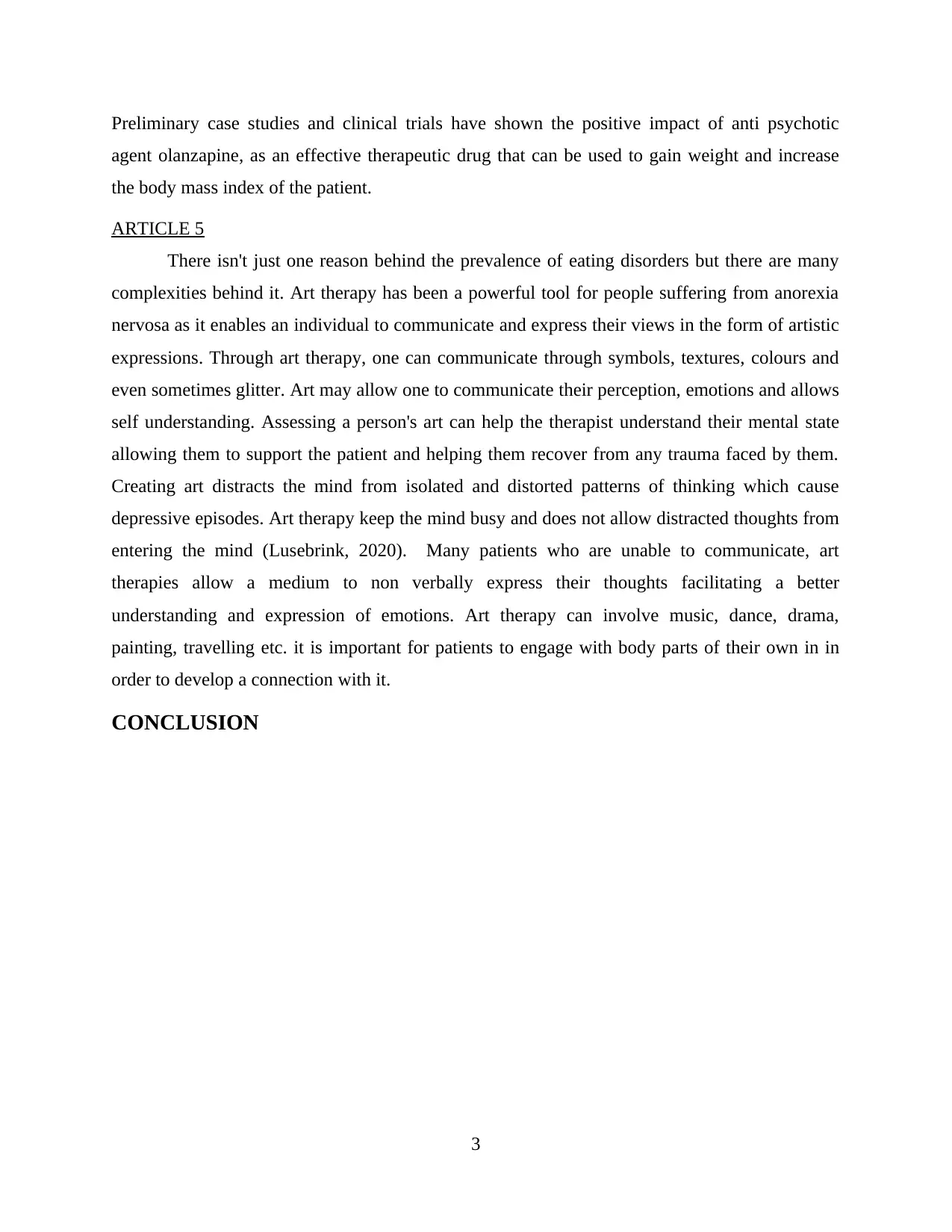
Preliminary case studies and clinical trials have shown the positive impact of anti psychotic
agent olanzapine, as an effective therapeutic drug that can be used to gain weight and increase
the body mass index of the patient.
ARTICLE 5
There isn't just one reason behind the prevalence of eating disorders but there are many
complexities behind it. Art therapy has been a powerful tool for people suffering from anorexia
nervosa as it enables an individual to communicate and express their views in the form of artistic
expressions. Through art therapy, one can communicate through symbols, textures, colours and
even sometimes glitter. Art may allow one to communicate their perception, emotions and allows
self understanding. Assessing a person's art can help the therapist understand their mental state
allowing them to support the patient and helping them recover from any trauma faced by them.
Creating art distracts the mind from isolated and distorted patterns of thinking which cause
depressive episodes. Art therapy keep the mind busy and does not allow distracted thoughts from
entering the mind (Lusebrink, 2020). Many patients who are unable to communicate, art
therapies allow a medium to non verbally express their thoughts facilitating a better
understanding and expression of emotions. Art therapy can involve music, dance, drama,
painting, travelling etc. it is important for patients to engage with body parts of their own in in
order to develop a connection with it.
CONCLUSION
3
agent olanzapine, as an effective therapeutic drug that can be used to gain weight and increase
the body mass index of the patient.
ARTICLE 5
There isn't just one reason behind the prevalence of eating disorders but there are many
complexities behind it. Art therapy has been a powerful tool for people suffering from anorexia
nervosa as it enables an individual to communicate and express their views in the form of artistic
expressions. Through art therapy, one can communicate through symbols, textures, colours and
even sometimes glitter. Art may allow one to communicate their perception, emotions and allows
self understanding. Assessing a person's art can help the therapist understand their mental state
allowing them to support the patient and helping them recover from any trauma faced by them.
Creating art distracts the mind from isolated and distorted patterns of thinking which cause
depressive episodes. Art therapy keep the mind busy and does not allow distracted thoughts from
entering the mind (Lusebrink, 2020). Many patients who are unable to communicate, art
therapies allow a medium to non verbally express their thoughts facilitating a better
understanding and expression of emotions. Art therapy can involve music, dance, drama,
painting, travelling etc. it is important for patients to engage with body parts of their own in in
order to develop a connection with it.
CONCLUSION
3
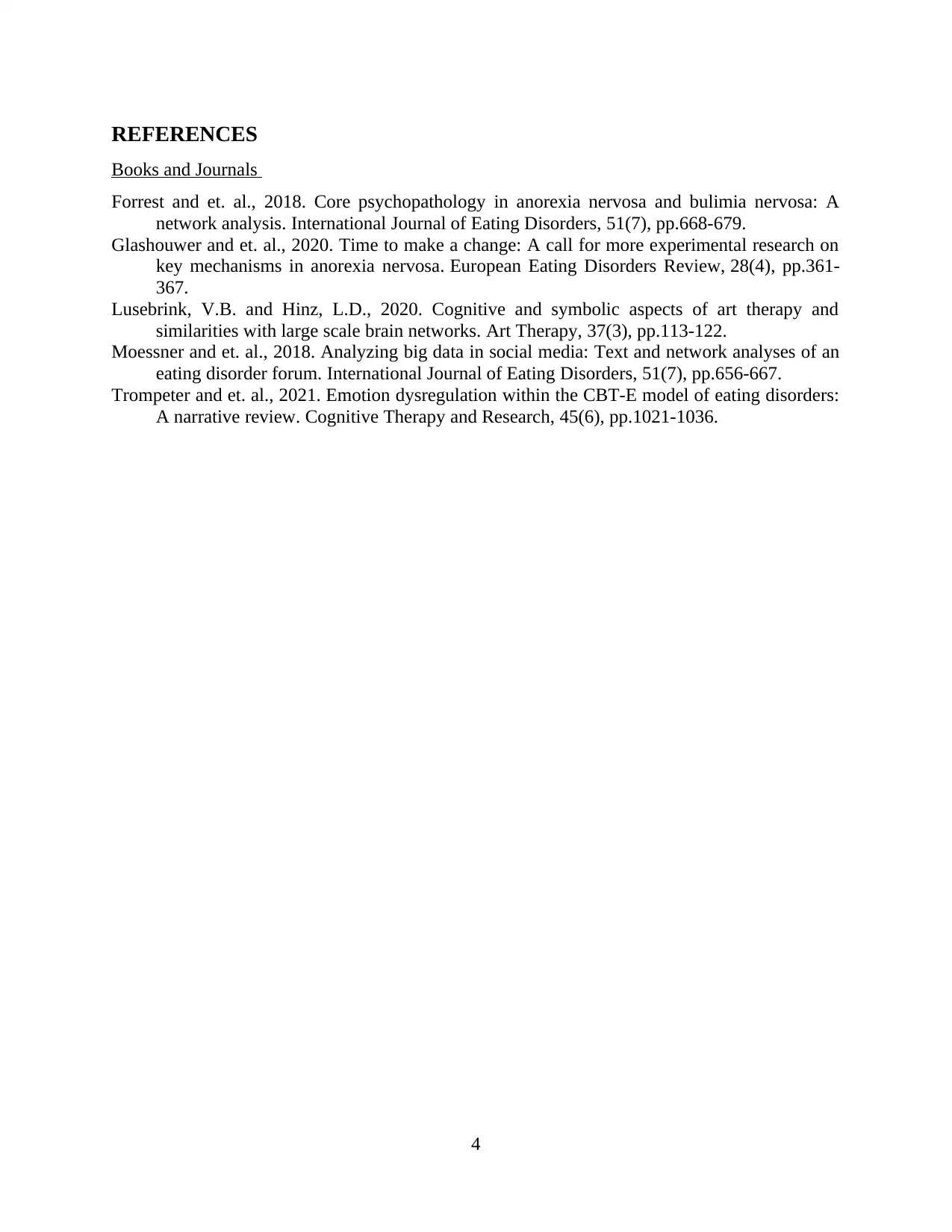
REFERENCES
Books and Journals
Forrest and et. al., 2018. Core psychopathology in anorexia nervosa and bulimia nervosa: A
network analysis. International Journal of Eating Disorders, 51(7), pp.668-679.
Glashouwer and et. al., 2020. Time to make a change: A call for more experimental research on
key mechanisms in anorexia nervosa. European Eating Disorders Review, 28(4), pp.361-
367.
Lusebrink, V.B. and Hinz, L.D., 2020. Cognitive and symbolic aspects of art therapy and
similarities with large scale brain networks. Art Therapy, 37(3), pp.113-122.
Moessner and et. al., 2018. Analyzing big data in social media: Text and network analyses of an
eating disorder forum. International Journal of Eating Disorders, 51(7), pp.656-667.
Trompeter and et. al., 2021. Emotion dysregulation within the CBT-E model of eating disorders:
A narrative review. Cognitive Therapy and Research, 45(6), pp.1021-1036.
4
Books and Journals
Forrest and et. al., 2018. Core psychopathology in anorexia nervosa and bulimia nervosa: A
network analysis. International Journal of Eating Disorders, 51(7), pp.668-679.
Glashouwer and et. al., 2020. Time to make a change: A call for more experimental research on
key mechanisms in anorexia nervosa. European Eating Disorders Review, 28(4), pp.361-
367.
Lusebrink, V.B. and Hinz, L.D., 2020. Cognitive and symbolic aspects of art therapy and
similarities with large scale brain networks. Art Therapy, 37(3), pp.113-122.
Moessner and et. al., 2018. Analyzing big data in social media: Text and network analyses of an
eating disorder forum. International Journal of Eating Disorders, 51(7), pp.656-667.
Trompeter and et. al., 2021. Emotion dysregulation within the CBT-E model of eating disorders:
A narrative review. Cognitive Therapy and Research, 45(6), pp.1021-1036.
4
⊘ This is a preview!⊘
Do you want full access?
Subscribe today to unlock all pages.

Trusted by 1+ million students worldwide
1 out of 6
Related Documents
Your All-in-One AI-Powered Toolkit for Academic Success.
+13062052269
info@desklib.com
Available 24*7 on WhatsApp / Email
![[object Object]](/_next/static/media/star-bottom.7253800d.svg)
Unlock your academic potential
Copyright © 2020–2025 A2Z Services. All Rights Reserved. Developed and managed by ZUCOL.





